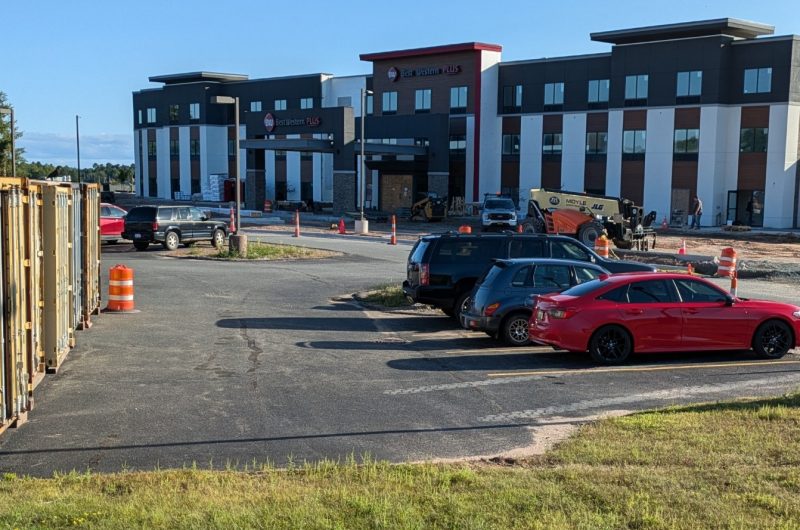Changing demographics and employment structure bring long-term challenges to the Upper Peninsula
The opinions expressed in this publication are those of the authors, and do not necessarily reflect the opinions or views of Rural Insights or its members.

Back in August 2016, I presented a report to Governor Snyder as part of Project Empire that had the goal of helping local leaders address the economic and social challenges brought about by the closure of the Empire Mine.
Since then, Marquette County has witnessed the completion of several major construction projects, including UP Health Systems Hospital, One Marquette Place, the Residences at Harbor Vista, a new 195,000-square-foot Meijer supercenter, the reconstruction of US 41 in Marquette Township, a 1,200-person residence hall at Northern Michigan University, and the transformation of the University Center into the Northern Center.
To the casual observer it would appear that all is well. Rent for two-bedroom apartments at One Marquette Place and the Residences at Harbor Vista run about $1,850 per month, and there appears to be no shortage of takers.
Yet, despite these and other recent investments, there remain long-term challenges for the region.
I will outline two of them: demography and employment structure.
Demography
Marquette County’s population peaked in 1980 at approximately 74,000, and has since fallen by about 6,500 with the biggest drop occurring during the 1990s due to the closing of Sawyer Air Force Base.
For the past decade, the Census Bureau estimates a small decline in the county’s population from 67,071 to 66,699. The fall in population is partly attributable to an excess of deaths over births.
The number of babies born in Marquette County between 2010 and 2018 totaled 5,663, while during the same period deaths totaled 5,946. This net loss of 283 persons increases the importance of in-migration to maintaining the region’s population.
However, IRS data on county in-migration and outmigration, based on address changes on individual income tax returns over consecutive years, indicates a troubling pattern.
Despite the fact that not all people file tax returns, between 2011-12 and 2017-18 the number of out-migrants amounted to 9,445, while in-migrants numbered 8,170–a net loss of 975 households (a change in IRS methodology precludes comparisons with earlier years).
When the total adjusted gross income for in- and out-migrants is compared, Marquette County experienced a loss of about $17 million in local purchasing power over the period. At the same time, the region is confronting the challenges of an aging population.
The number of retirees receiving social security income in the Marquette, Ishpeming and Negaunee zip codes went from 6,750 in 2010 to 8,975 in 2018, with total monthly benefits increasing from approximately $8 million to $13 million during the same period.
Employment Structure
US Bureau of Labor statistics indicate that Marquette County’s labor force in 2010 was approximately 35,000; by 2019 this number had dropped to 32,500.During the same period the number of employed persons fell by 500.
The reasons for these declines can be found in an aging population and examining the fortunes of three of the county’s largest employers: Northern Michigan University, UP Health System, and Cleveland Cliffs. All three have shed employees.
For Northern Michigan University (NMU), declines in enrollment and the associated drop in tuition revenue have forced the university to cut back on hiring. Total enrollment peaked in 2007, with 9,689 students (8,880 undergraduates and 809 graduates). By fall 2019, enrollment was down to 7,732 (7,136 undergraduates and 596 graduates).
Much of the enrollment decline is attributable to a reduction in the number of high school graduates in the Midwest. Falling enrollment has meant a reduction in the number of full-time employees from 976 to 924 during the same period.
In August 2012, Michigan’s Attorney General approved the sale of non-profit Marquette General Hospital to for-profit Duke LifePoint of Brentwood, Tennessee. A year later, LifePoint acquired Ishpeming’s Bell Hospital.
In 2013, Duke LifePoint reported a local payroll of $166.7 million–by 2018 this figure had dropped to $143.3 million. Part of this decline is attributable to a 20 percent drop in employment from 2,324 in 2015 to 1,874 three years later.
The other remaining pillar of the local economy is Cleveland Cliffs.
Back in 2015 before the Empire mine closed, Cliffs reported employing 1,292 persons with a $173 million payroll and purchasing $462 million worth of local services and supplies. In the aftermath of the Empire mine’s closure, employment fell to 920 in 2018, with the payroll dropping to $141 million and local purchases to $333 million.
All three have suffered further shocks in 2020. The hospital was forced to delay elective surgeries as part of Governor Whitmer’s plan to deal with COVID-19, and in response, up to 100 workers were laid off without pay at the end of March.
Confronted with the COVID-19 outbreak, NMU–like all public universities in the state–switched to delivering courses online in March. A month later, the university’s president predicted a 10-percent fall in enrollment for fall 2020, and an even larger drop in state support for the institution.
Fewer students will mean less money spent in the local economy.
Finally, in April, Cliffs announced a plan to temporarily idle the Tilden mine for three months and lay off about 700 workers due to the drop in demand for iron ore.
Needless to say, these are challenging times for all employers regardless of their size, and the full impact of COVID-19 on the local economy is still to be determined.
Economic Diversification
Public officials have recognized the need to diversify the region’s economy for some time, and a variety of initiatives have been implemented over the past decade–including the establishment of a Smart Zone in Marquette and Invent@NMU, which provide support services to technology firms and entrepreneurs.
A grant from the state helped pay part of the cost of rehabbing the Masonic Building in downtown Marquette for a coworking space. This is in addition to local existing economic development efforts undertaken by the Lake Superior Community Partnership and the City of Marquette.
The challenges that confront Marquette County are not unique; they are common to other communities in isolated regions of America.
In the past, that isolation has been regarded as yet another challenge as young people have left to find work in metropolitan areas, but in the COVID-19 era the appeal of living in densely populated urban areas might lose some of its sheen.
Instead, living and working in an isolated region could now be seen as an asset.






Well done. These are troubling trends.
What constitutes homeostasis for the UP and Marquette? Useful book (available at Snowbound Books) is Prisoners of Geography. The title says it all. Geography points to limits but also to potentials.
Interesting article on economics slow down in Marquette County. I agree, our isolation and setting In the UP amid the COVID-19 pandemic does make our region more attractive, especially in light of remote working becoming more commonplace.
When I retired from the US Air Force in 1992 I was stationed at a base in San Antonio. I decided to move to Marquette County because I liked the size of the City of Marquette, and saw the area as having great potential. A University Community on the shores of Lake Superior, with a Regional Hospital, a Downtown that looks like a Downtown, and excellent K-12 school districts. I think we have a lot more positives than negatives.